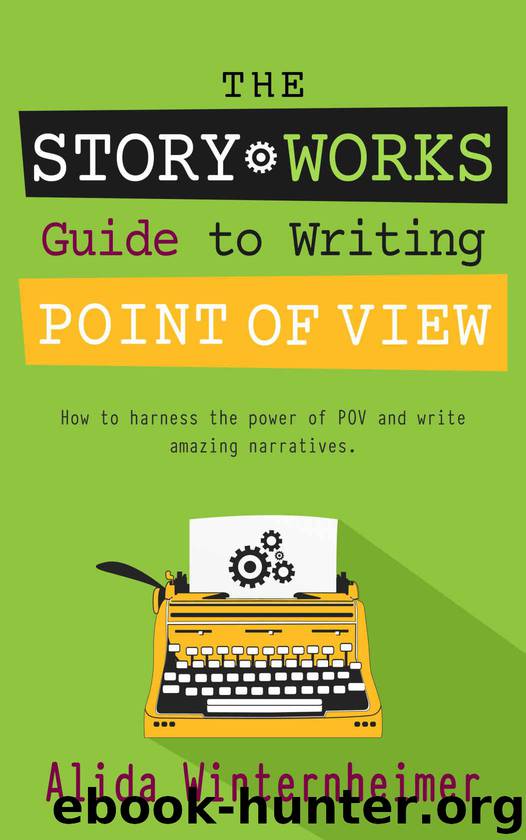The Story Works Guide to Writing Point of View: How to harness the power of POV and write amazing narratives. (The Story Works Guide to Writing Fiction Book 2) by Winternheimer Alida

Author:Winternheimer, Alida [Winternheimer, Alida]
Language: eng
Format: azw3, epub
Publisher: 28.5press
Published: 2017-06-06T16:00:00+00:00
These rules established a narrative framework for my stories that immediately established the omniscient point of view for the reader.
Let’s look at an excerpt from “The Herd” to see how the shifts in perspective are handled.
Rey and Tegan stand up on their towels, tucking their magazines under their beach bags so they won’t blow away, then Tegan starts toward the water. She has a walk she has been working on. She drags the tips of her toes through the sand as she steps forward, making certain to cross one foot in front of the other. Also, one hand rests lightly, jauntily, upon her hip. She has taken some dance classes and watches models on the catwalk on YouTube. These are the sources of her new affectation. Rey has held back so that she can look down at her cousin. “Well?” she says. “Are you coming in with us?” Her hips are cocked, but this is not an affectation. This is a display of her impatience with and disapproval of Suzie.
Suzie shrugs. “Okay.”
A man on the beach watches the girls enter the water. He watches Suzie especially. He likes her plumpness. This man does not understand why she is self-conscious, but he understands vulnerability. He watches Suzie enter the water. Her friends run in, squealing and splashing, but she steps in, hesitantly, testing her way.
A little boy wearing water wings scoops sand into a pail at the edge of the water. Suzie comes dangerously close to stepping in the hole he is digging, to collapsing its sidewall. He looks up, but cannot see Suzie’s face because of the sun. It forces him to close his eyes completely and drop his head. Thomas is a serious boy, which is why his parents call him Thomas, not Tom and certainly not Tommy. His entire world is that hole in the sand. He hopes that if he digs deep enough he will find a crab, or perhaps a mermaid. He reminds himself that mermaids live in deep waters with the bass and walleye that his grandpa pulls out of the lake. He is, therefore, unlikely to find a mermaid in his hole. But, he thinks, I might find a mermaid’s skull! and he continues to dig. He will dig with perfect concentration until he gets bored, or until his mother calls him back to the blanket for a snack.
Published in Water~Stone Review, vol.16.
Controlling your narrative means every choice you make is guided by its relevance and how it advances the story. Is that chair’s perspective important to the story? Does it advance us toward a climactic moment of some kind? If so, then ask, when is the chair’s perspective most relevant? Is it an amusing voice appropriate to hear throughout? Should the chair come in after the old woman who sat in it dies?
Because an omniscient point of view means working with multiple point of view characters, you can apply the same questions that guide multiple points of view to the omniscient point of view.
Download
The Story Works Guide to Writing Point of View: How to harness the power of POV and write amazing narratives. (The Story Works Guide to Writing Fiction Book 2) by Winternheimer Alida.epub
This site does not store any files on its server. We only index and link to content provided by other sites. Please contact the content providers to delete copyright contents if any and email us, we'll remove relevant links or contents immediately.
And Here's the Kicker: Conversations with 21 Top Humor Writers on Their Craft by Mike Sacks(1065)
2024-2120 by Russell Fine(881)
2120-2126 by Russell Fine(879)
Letters to a young poet by Rainer Maria Rilke(738)
You Should Be Writing by Brenda Knight & Brenda Knight(725)
550 AP Calculus AB & BC Practice Questions by Princeton Review(705)
How Tell a Story and Other Essays by Mark Twain(691)
Reading for the Plot by Peter Brooks(681)
Poetics (Penguin Classics) by Aristotle(652)
Cultures and Beyond (The Art of World Building Book 3) by Randy Ellefson(617)
Improve Your Writing with NLP by Judith Pearson(613)
Letters to a Young Poet (Rediscovered Books) by Rainer Maria Rilke(600)
The Story Works Guide to Writing Point of View: How to harness the power of POV and write amazing narratives. (The Story Works Guide to Writing Fiction Book 2) by Winternheimer Alida(593)
Odessa Stories by Isaac Babel(584)
The Hidden Writer by Alexandra Johnson(567)
Story Structure Architect by Schmidt Victoria Lynn(562)
Mastering the Process by Elizabeth George(560)
Confident Digital Content by Adam Waters(557)
The George Sand-Gustave Flaubert Letters by George Sand & Gustave Flaubert(555)
